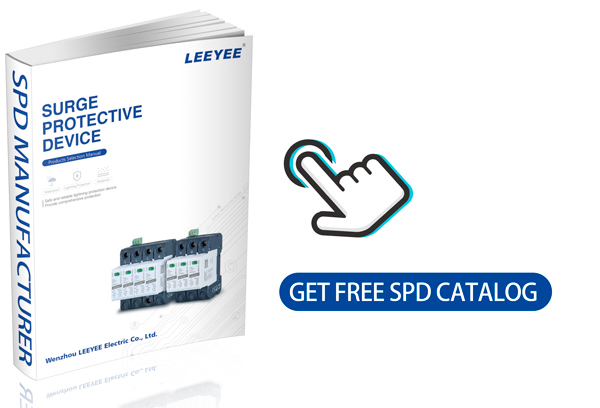Power surges silently damage assets, halt production, and increase repair costs. LEEYEE, a specialist in lightning protection, offers premium SPDs for solar and industrial systems, delivering above-average discharge capacity.
A power surge means a sudden voltage spike that exceeds normal levels and disrupts system operation. To protect sensitive electrical systems, Surge Protection Devices (SPDs) must be installed in power distribution and PV applications.
To fully understand power surge risks and solutions, let’s explore the sources, consequences, and how LEEYEE’s SPDs offer a strategic safeguard.
Power Surge Means: Technical Insight & Engineering Perspective
Simply put, a sbalzo di tensione occurs when voltage briefly rises above the rated level—commonly above 250V in a 220V system. Even though the spike lasts only microseconds, it can severely damage connected equipment.
What Causes Power Surges?
Several factors may lead to a power surge, and recognizing them is the first step to prevention:
-
Lightning strikes can inject up to 1 million volts into systems through overhead lines.
-
Switching loads—such as motors or capacitors—cause internal surges that account for over 60% of equipment failures in industrial systems (source: IEEE Std 1100-2005).
-
Grid fluctuations occur due to utility switching or transformer faults.
-
Improper grounding or reversed polarity during maintenance work can also trigger voltage spikes.
-
Backfeeding from solar inverters or generators without proper isolation can result in damaging reverse currents.
These sources can cumulatively stress insulation, degrade semiconductors, and accelerate aging of electrical systems.
Why Power Surges Matter in Industrial and Solar Systems
A small surge—only a few hundred volts—can damage a programmable logic controller (PLC), sensor, or inverter. In PV systems, where DC voltage can reach 1000V, the risk is even higher.
For example, without proper SPD protection, a 20kA lightning-induced surge in a PV system can:
-
Burn inverter IGBTs
-
Trigger arc faults in junction boxes
-
Shorten module lifespan
-
Corrupt SCADA or remote monitoring signals
Consequently, system downtime increases, operational costs spike, and in worst-case scenarios, fire hazards may develop.
SPD Technology: An Effective Countermeasure
To address these problems, LEEYEE manufactures certified Surge Protection Devices (SPDs) engineered for industrial and photovoltaic systems. Unlike generic units, these SPDs:
-
React within 25 nanosecondi
-
Handle nominal discharge currents up to 20kA
-
Sustain maximum discharge current levels reaching 100kA
-
Limit voltage to <1.8kV (AC) o <2.5kV (DC) depending on system type
These parameters rank LEEYEE among the leaders in China’s lightning protection industry.
Product Application and Integration
It is crucial to match the SPD type to the system it protects:
-
Type 1 SPDs handle direct lightning strikes—ideal for main power entrances.
-
Type 2 SPDs are for residual surges in sub-distribution panels.
-
Type 3 SPDs protect terminal devices like servers or programmable controllers.
Additionally, in PV systems, SPDs must be installed at both the DC side (close to solar panels) and the AC side (near the inverter output), ensuring complete protection. Proper SPD coordination guarantees staged clamping without short-circuit risks.
Why Choose LEEYEE for Surge Protection?
Fondata nel 2009, Wenzhou LEEYEE Electric is a trusted manufacturer focusing on lightning protection solutions. With over 8,000m² of production space, OEM/ODM customization, and a two-year warranty, LEEYEE supports clients across:
-
Power distribution networks
-
Industrial automation facilities
-
Photovoltaic and wind energy systems
-
EV charging infrastructure
Every product carries CE, TUV, CB, and ISO9001 certification, and clients are encouraged to request factory audits or third-party verification before purchase.
Best Practices for SPD Deployment
To maximize performance:
-
Install SPDs in parallel, minimizing cable length to reduce inductive impedance.
-
Use dedicated grounding conductors—resistance should be <10 ohms.
-
Check coordination values (Uc, Up, In) to avoid overprotection or underperformance.
-
Maintain the devices regularly and replace them after major surge events.
For instance, a 20kA surge event reduces an SPD’s life cycle significantly; periodic diagnostics help detect such degradation.
Surge Risk by Region
Surge exposure varies geographically. In Southeast Asia, Sub-Saharan Africa, e the Middle East, high thunderstorm frequency and unstable grids increase the need for robust SPD integration. For global operations, adapting protection strategies to local surge patterns becomes essential.
FAQs: Power Surge Means
Q1: What does a power surge mean in electrical terms?
It refers to a rapid voltage spike that surpasses the standard operating range of electrical equipment, often damaging sensitive components.
Q2: Is a power surge always caused by lightning?
No. While lightning is a major factor, most surges originate internally from switching operations, motors, or faulty grounding.
Q3: How does an SPD work?
An SPD redirects excess voltage to ground, clamping the voltage spike to a safe level instantly—usually within nanoseconds.
Q4: Do SPDs protect against sustained overvoltage?
No. SPDs are designed for transient events. For long-term voltage anomalies, use under/over voltage protectors.
Q5: What SPD parameters are most important?
Focus on Corrente di scarica nominale (In), Corrente di scarica massima (Imax), Tempo di risposta, e Livello di protezione della tensione (su).
Q6: How often should SPDs be replaced?
After multiple large surges or at manufacturer-recommended intervals. Indicator windows or monitoring systems can signal failure.
Q7: Can I install SPDs myself?
Professional installation is advised, especially for industrial systems, to ensure correct grounding and coordination.
Final Thoughts
When it comes to safeguarding modern electrical infrastructure, understanding what power surge means and acting with the right protective measures is non-negotiable. In high-value systems like solar, industrial automation, or data centers, SPDs offer measurable ROI by preventing loss and enhancing uptime.
Esclusione di responsabilità:
This article provides general technical guidance. For site-specific analysis, system design, or installation, please consult a licensed electrical engineer or certified surge protection specialist.

